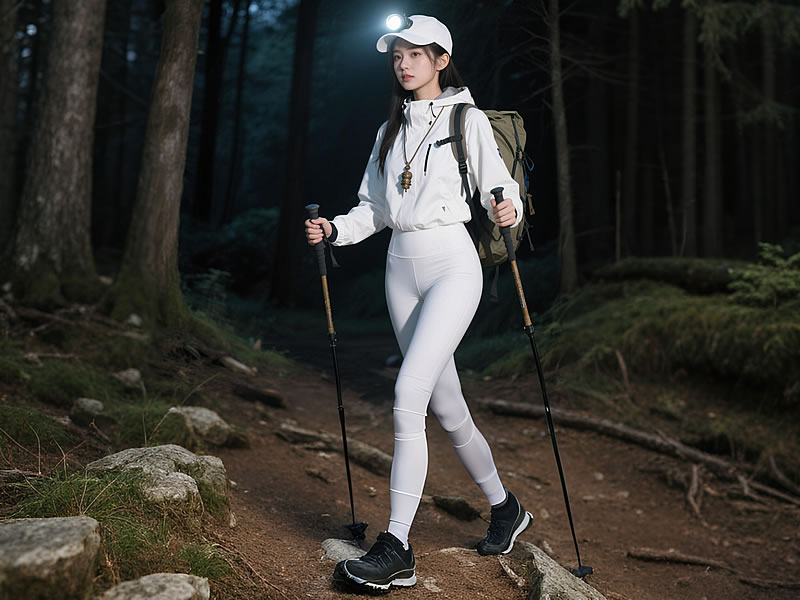Night hiking tips for beginners?
Hiking under stars transforms trails—but 43% of search/rescues occur after dark (NPS). For beginners, mastering night travel unlocks solitude, wildlife encounters, and beating heat. Here’s how to hike safely when the sun drops.

🌑 Why Hike at Night?
- Avoid Crowds: 92% of hikers are daytime-only (AllTrails).
- Beat the Heat: Desert/Summer temps drop 20–30°F.
- Wildlife Magic: Spot owls, foxes, bioluminescent fungi.
- Full Moon Navigation: Moonlight provides 0.1–0.3 lux illumination (vs. 0.001 lux new moon).
🔦 Light System: Your Lifeline
| Light Type | Purpose | Specs |
|---|---|---|
| Primary Headlamp | Trail illumination | 300+ lumens, 4000K neutral white (reduces glare) |
| Backup Light | Emergency redundancy | Handheld flashlight + spare batteries |
| Red Light | Preserve night vision | Essential for map reading/camp tasks |
| Glow Sticks | Mark camp/trail junctions | Chemical-free options (last 8+ hrs) |
Critical: Test all lights pre-hike. Cold drains lithium batteries 40% faster.
🧭 Navigation: Avoid "Night Panic"
- Pre-Load Offline Maps: Gaia GPS or CalTopo with route waypoints.
- Reflective Trail Markers: Place 3M tape on trees every 200ft (remove post-hike).
- Avoid Shadows: Moon casts "false trails" on slopes—stick to established paths.
- Aspect Awareness: South-facing slopes stay visible longest after sunset.
Pro Tip: Attach a suction cup compass to your headlamp strap for hands-free bearings.
👣 Terrain Tactics: Walk Like a Ninja
- Pace Control: Stride 50% slower—rocks/roots hide in shadow depth.
- Pole Probing: Tap ground before weight shift (detects drop-offs).
- Footwork Focus: Scan 6ft ahead with light; avoid "target fixation" on beam.
- Step Height: Lift feet 2x higher than daylight hiking.
Data: Night falls increase tripping injuries by 78% (Wilderness Medicine Journal).
🌡️ Thermal Management: The Invisible Killer
- Layer Progression:Base: Merino wool (wicks sweat)Mid: Fleece or synthetic puffyShell: Windproof jacket (blocks convection chill)
- Extremities Priority: Wear gloves + beanie before you feel cold (20% heat loss via head).
- Hypothermia Alert: Shivering starts at core temps of 95°F (35°C).
🐺 Wildlife Protocol: Beyond the Beam
- Coyotes/Bobcats: Shine light directly at eyes → they retreat.
- Mountain Lions: Never run. Make noise, appear larger, back away slowly.
- Snakes: Stay on trail; they’re inactive below 55°F (13°C).
- Rodent Caution: Pack food in rodent-proof opsaks—mice chew tents at night.
🌙 Moon Phase Strategy
| Phase | Visibility | Beginner Advice |
|---|---|---|
| Full Moon | Excellent | Hike open ridges; minimal light |
| Quarter Moon | Moderate | Stick to forest edges |
| New Moon | Poor | Avoid technical terrain |
Golden Hour Hack: Start hiking 60–90 mins before sunset to adapt gradually.
⚠️ 5 Deadly Beginner Mistakes
- Solo Hiking: Always bring a partner—disorientation risks multiply at night.
- Overestimating Fitness: Night hiking feels 30% harder (depth perception loss).
- Ignoring Weather: Rain + dark = hypothermia accelerator.
- No Bail-Out Plan: Identify escape routes every mile.
- Blue-White Lights: Harsh 6000K beams create blinding backscatter.
🎒 Gear Checklist: Beyond Lights
- Emergency Bivy: SOL Escape weighs 5oz—critical if stranded.
- Thermal Socks: Carry 3x pairs; sweat-free feet prevent frostnip.
- Whistle: Carries 1.5 miles vs. shouts at 200yds.
- Caffeinated Gels: Combat "night fatigue" dips (use sparingly).
"The night doesn’t forgive navigational errors. If doubt creeps in, stop, sit, and reassess—panic is your real enemy."—Appalachian Trail SAR Team
Start Smart: Try 2–3 mile loops near home first. Master moonlit meadows before mountain traverses.






